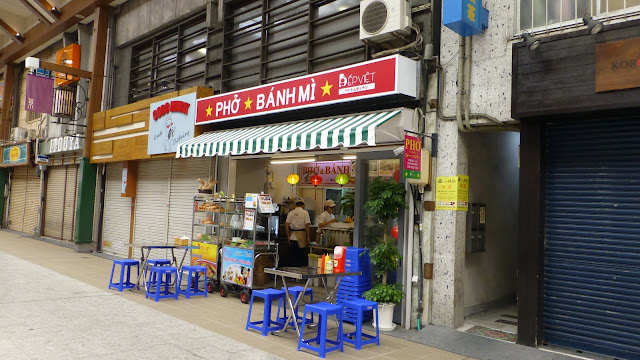On this 24 hour stopover in Nagoya, I inadvertently stumbled into one of my favourite places ... a shotengai or covered shopping street.
More than a block or two long, Nagoya's Osu Shopping district consists of a network of several streets, pure bliss to a shotengai addict like myself.
You can have your air conditioned malls and super shopping centres -- give me a traditional, quaint shotengai every time!

One of the main entrances to the Osu shotengai is right outside the Osu Kannon Temple.
This is Nioumon street.
Do you see the fierce face on the wall on the top left of this photo? He must be the the defender of the shotengai -- to make sure that everyone who enters parts with some of their money and leaves it behind in one of the stores.
This is Nioumon street.
Do you see the fierce face on the wall on the top left of this photo? He must be the the defender of the shotengai -- to make sure that everyone who enters parts with some of their money and leaves it behind in one of the stores.

This friendly little poodle was all decked out in a vest -- just like his owner, the shopkeeper.
I wonder if he gives out discounts?

It was just past 10 in the morning and some of the stores had not yet opened.

I browsed through stores selling senbei or rice crackers and other traditional snacks ...

and specialty shops like this one that made various types of bean stuffed pastries.

Small stores like this selling various sundries from hosiery to shampoo to tonics seem like a throwback to another shopping era.

"Brand" shops like this can be found all over Japan. You can find pre-loved name brand purses and luggage at a fraction of the cost. The Japanese are some of the world's top shoppers of high end luxury brands and quickly turn over last season's it bag for this season's must have. Their discards, still quite new looking find their way to these discount stores.
Japanese of a certain age have a penchant for hats -- whether male or female, they wear them at all seasons of the year. The hat shop is an ubiquitous feature in the shotengai.
Looking for summer yukatas or traditional coats -- there are stores selling all kinds for all types of styles and budgets.

For bargains and pasalubong, the 100 yen store is always a good idea.
There are all sorts of cute-but-useless items not to mention your everyday mundane useful stuff inside.
The owner of this bag shop was a very persuasive old lady -- I should know because I ended up buying a small sling bag when I stopped to just look at her displays.
There is a Christian chapel tucked in between the various storefronts. If I hadn't glanced up I would not have noticed the cross.
The church was running an art exhibit with proceeds going towards its various projects.
At the end of the block is more of the shotengai. If you turn left or right, there are more stores all along the side streets. The Osu shopping district has more than 1,000 shops, cafes and restaurants to choose from -- shop till you drop in Nagoya!
This portion of the shotengai takes you from small local boutiques to shops with a more "international" flavour -- Italian pizza and Istanbul coffee are right across from each other.
There is a bazaar selling halal food items, souvenirs and middle eastern dry goods.
What would be right next to the halal shop but a kebab place?
This Vietnamese restaurant advertises its pho and those delicious baguette sandwiches, the banh mi.
This is truly the global food area ... how about some Brazilian cuisine? The chicken spinning on the rotisserie gave off such tempting smells.
If you're up for a bossa nova beat, you can linger at Pukio where you can even learn to play
Latin music. The llamas are friendly too.

While cars are free to pass on the side streets surrounding the shotengai, the covered areas are pedestrian only thoroughfares with a few delivery vehicles allowed in. Watch out for the bikes though as the residents bring their mamachari bikes when they go shopping.
At the end of the street is Fureai Plaza with a huge statue of the maneki neko,
the "waving" cat that is a symbol of luck and good fortune. Come in to the shotengai, it seems
to say. Come in and leave your fortune behind in the many stores inside.
I ran away from the maneki neko before he could beckon more money from my wallet and found myself in Banshoji street, another part of the Osu Shopping district.

The stores here were larger and featured well known Japanese brands. I missed the slow paced vintage feel of Nioumon Street, with its quaint, old-fashioned stores.
Looking for shoes? You can always find something at ABC Mart, the mega shoe chain found everywhere in Japan.
It was nearly lunchtime and more shoppers had arrived. Shotengai cater basically to locals so you
are generally spared the jostling, pushy mobs of foreign tourists buying everything they can get their hands on.
The are contemporary everyday fashion along Banshoji street. There are vintage clothing shops
and even some stores that are branches of well known shops in Tokyo.
More shops loomed ahead and I could have gone on and on but I had to get back to Nagoya
station to catch the shinkansen to Tokyo. I would have to explore Shintenchi street some other time.
Good bye for now, Osu Shopping District -- certainly the biggest shotengai I had ever seen in Japan.
P.S.
The Osu shotengai is well signposted and laid out in an orderly grid. You may lose yourself in the shopping but you will certainly not get lost. Here's a map of the area that I got from http://inbound.nagoya-osu.com/customize_image/map.pdf.
Happy shopping!














































